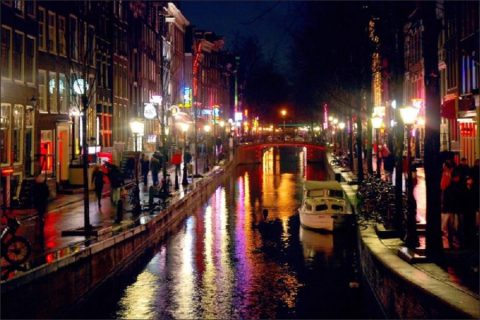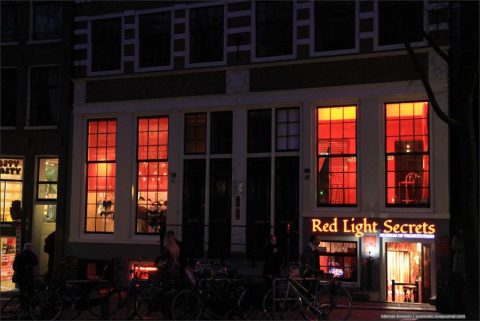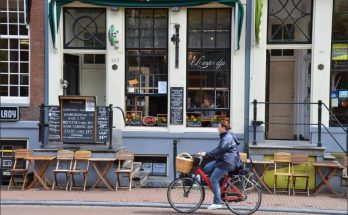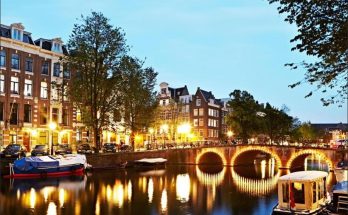Here we are in Amsterdam at the fag-end, if that’s the right expression, of International Fashion Week. “Spectators will be blown away by the originality and flare of some of Holland’s finest designers,” says the publicity blurb. “Cutting-edge fashion at its best.”
The only word I recognise there is “flare” – several pairs of these have been feeding the moths in my attic since the 70s – but there’s no doubt Amsterdam has style.
You can see it in the way Amster-dammers dress, elegantly and casually, even on this bitterly cold winter’s day with an east wind whipping off the semi-frozen canals. You can see it in the architecture, a mix of beautifully-gabled canalside houses, huge gothic churches and ultra-modern office buildings.
And you can see it in the atmospheric old bars and cafes where people sit under reading lamps scanning the newspapers and sipping small glasses of jinever, the local gin.
Amsterdam is as close to the perfect weekend break as you can get. It’s a cheap and cheerful 50-minute flight from the UK and has a wide range of reasonably-priced hotels and legendary nightlife.
But there’s slightly more to the place than that. Gezellig is a word which the Dutch use a lot. It has no real English equivalent – “cosy” is probably the closest you’ll get. But it could also mean friendly, relaxed or untroubled. And that’s Amsterdam for you. Here’s our guide…
The Sights
THERE are five main tourist areas in the centre of Amsterdam and you can easily cover all of them in a pleasant day’s stroll.
Jordaan is a warren of streets and canals with a village atmosphere. It has some great pavement cafes, posh shops and the huge De Looier indoor antique market.
Leidseplein is where young locals hang out in its bars and cafes. During the day, particularly in the summer, the square is packed with street performers.
The Museum Quarter, just south of the Singel Canal, is home to the Rijksmu-seum and the Van Gogh Museum. Here you’ll also find the Museum Of Modern Art, the city’s main concert hall and the leafy Vondelpark. Designer shops and top-end restaurants are squeezed between the old merchants’ houses.
Rembrandtplein is a huge square close to the floating Flower Market and Utrechtstraat, which is another popular eating and shopping area.
Dam Square is the centre, the Piccadilly Circus of Amsterdam. The white National Monument is framed by the Koninklijk Paleis, the 17th century town hall, on one side and the Bijenkorf department store on the other. In between there’s a clatter of trams and the tinkle of bicycle bells.
To avoid the bustle of tourists, head east to the house of Rembrandt van Rijn, arguably one of the greatest artists ever to put brush to palette. It’s his 400th birthday this year and, to celebrate, his 17th century house near the banks of a canal in Jodenbreestraat will be staging various exhibitions (www.rembrandt huis.nl).
But frankly, there’s no need to embellish this charming little place. The house, where Rembrandt lived and worked from 1639 until 1656, when he went bankrupt, has been faithfully restored with contemporary furniture and many of the master’s exquisite etchings.
The effect is not so much a museum, more a case of popping round to see an old friend. You can smell the linseed in his paint and see the light which inspired his greatest masterpieces slanting through the latticed windows of his studio.
It’s a rather different story down the road at the Rijksmuseum (www.rijksmuseum.nl). This huge building contains more than a million pieces of art, including paintings by Vermeer and Rembrandt.
And the nearby Van Gogh Museum is a little more manageable, with around 700 of his drawings and paintings (including his famous Sunflowers).
There’s a Canal Bus which whizzes round the city’s outer canals and you could take this to Amsterdam’s other big attraction, Anne Frank House.
There’s usually a queue outside but it’s worth the wait. The place is focussed on the secret attic room where Anne Frank and her family spent two years hiding from the Nazis. There is also a small museum about Jewish persecution – it’s a moving experience.
Eating Out
DUTCH food isn’t exactly anything to write home about – think chips, cheese and mayonnaise – but fortunately the city has just about every kind of cuisine, from Asian to South American (there are a surprising number of Argentinian steak houses around Dam Square).
The best French restaurant in town is Premiere Klas, an elegantly-mirrored place at Centraal Station. Top Thai (www.topthai.nl), near Anne Frank House, is a popular haunt, while Boom Chicago (www.boomchicago.nl) is a popular comedy club at the Leidespein Theatre which serves great food. Otherwise, you can get snacks in any of the hundreds of atmospheric bars throughout the city.
Nightlife
AMSTERDAM has its seedy side. There’s no point in skipping around this. In fact, many people come here specifically to let their hair – and often their trousers – down in a lost weekend of red lights and blue smoke.
But seedy is not strictly the right word. Scratch the surface of any big city and you’ll find prostitution and drugs being sold furtively in alleyways and dingy clubs with all the attendant dangers and rip-offs. Now that’s seedy. The difference is that Amsterdam has put all this behaviour on display, legalising it and thus diminishing – although not entirely eliminating – the power of gangs and unsavoury characters to exploit the punters. And the police make sure that no one steps over the line.
If you don’t want to visit the Red Light District, then take in a museum, a movie or a canal cruise. If you don’t fancy a trip to Cloud Nine in one of the scores of so-called “coffee-shops”, have a beer in a cosy wood-panelled bar instead.
Here’s a guide to what you should avoid. Or not, as the case may be…
Sex…
THE Red Light District is situated in the city centre, a few blocks east of Dam Square.
Here you’ll find girls with varying figures and degrees of attractiveness posing in about 400 window-fronts. They pay around pounds 100 to rent these sex showrooms for an eight-hour shift and charge from pounds 30 for a 15-minute “quickie”. A recent survey found that an impressive 40 per cent of their clients were British.
It can be a squalid existence for some, who are trapped in a cycle of drugs and debt, but many of the hookers are firmly in charge of their own lives, belonging to a union – called the Red Thread – and even filling in their tax forms every year.
Nearby, if you dodge the touts and the sex shops, you’ll find a series of live sex shows. These are popular with stag-dos (not to mention a few hen-parties) and approached with a fairly open mind they can be, well, interesting if you happen to be swotting up for your anatomy finals.
The most famous is the Theatre Casa Rosso (www.casarosso.com) which charges a flat pounds 20 a head entrance fee. Drinks can be expensive but it’s clean and not dingy. Along the street is the more downmarket Banana Bar where, for about pounds 30, you get all you can drink for an hour while watching naked barmaids doing their trademark banana routines. Your granny wouldn’t like it.
Of course, if you want to pretend that you’re only here to research the socio-economic impact of sex tourism you can always join a 015 organised Red Light Tour. They leave from the tourist office outside Centraal Station at 6pm every Friday and Saturday (www.robvanhulst.nl).
And Drugs…
THERE can’t be many cafes in the world where you can breezily march up to the counter and say: “I’ll have a bag of hash and some rolling papers, please. Oh, and I’ll just smoke it in the corner over there.”
Ten years ago the Dutch government decided to legalise its already-flourishing soft drugs industry by issuing licenses to so-called “coffee-shops” to sell hash and marijuana.
The theory was that if these were readily available, of good quality and sold at a fixed price – around pounds 8 for a bag – then the street-corner drugs trade would be put out of business.
The upshot has been either a huge success or a dismal failure, depending on whether you orbit Planet Zog or you believe that a spliff is the Devil’s Marlboro Light.
But even if a bang and a bong isn’t your bag, so to speak, it is well worth strolling through the Red Light District during the day and popping your head round the door of a coffee-shop.
You’ll soon see that these are certainly not stereotypical drug dens. In La Tertulia (www.coffeeshop amsterdam.com), a pastel-shaded coffee-shop on the banks of a canal, you’ll spot middle-aged men who could be your bank manager or accountant playing chess while sharing a joint.
It’s a bit like wandering into your local pub on a Saturday lunchtime, except that few of the coffee-shops are allowed to serve alcohol.
Other laid-back places to visit include the cosy Rookies Cannabis Cafe just off the Leidseplein, which doubles up as a small hotel, and Grey Area, run by two Americans, which has actually won awards for the quality of its cannabis.
The jury is still out on whether all this liberalisation has increased the use of hard drugs, such as cocaine and heroin, in the city.
But while much of the world is hellbent on banning even tobacco smoke, non-nannying Amsterdam shines like the glow on the end of a freshlypulled cigarette.
And Rock’n’Roll
DON’T be surprised if this drug culture spills over on to the dancefloor. In any of Amsterdam’s funky discos you’ll see people smoking joints. Technically it’s not allowed, although the authorities tend to turn a blind eye.
Amsterdam has a great nightlife and most clubs are open until three or four in the morning.
Leidesplein is the place to head for – clubs such as Jimmy Woo’s, Sugar Factory and Zebra are the most popular. While Cineac, in Rembrandtplein, is where Amsterdam’s upmarket crowd lounge in stylish and plush surroundings.
Getting THere
I STAYED at the Hotel Nova (www.novahotel.nl, doubles from pounds 60pn) a small three-star hotel in Neiuwezujds Voorburgwal, near Dam Square.
For daily flights to Amsterdam’s Schipol Airport, bmibaby (www.bmibaby.com) flies from Birmingham and Nottingham, Easyjet (www.easyjet.com) flies from Bristol, Gatwick, Liverpool, Luton and Stansted, KLM Cityhopper (www.klm.com) from Bristol, Cardiff, Humberside, London, Leeds, Norwich, Newcastle and Manchester, Jet2.com from Manchester, VLM (www.vlm.com) from London City. BA (www.ba.com) flies from Gatwick.
It’s worth buying an “I amsterdamcard” (EUR43 for two days) at any tourist office. It entitles you to free transport – including the Canal Bus – a guide book and admission to most of the museums.





